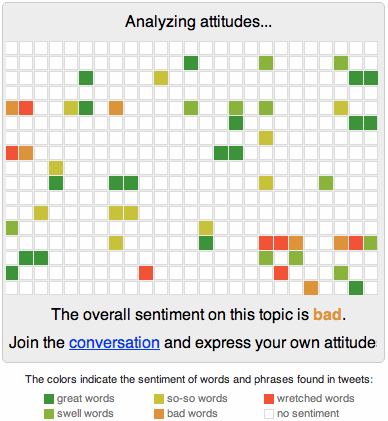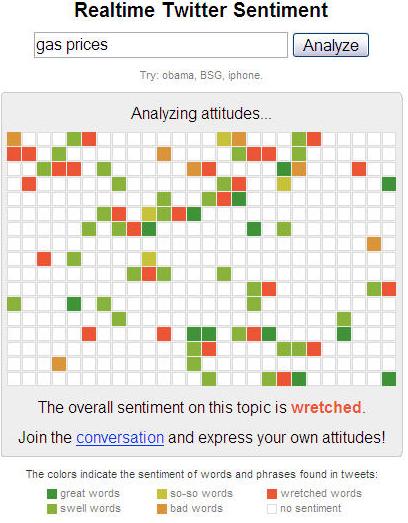Mingling at a Business Marketing Association luncheon yesterday, outside the conference room with my fellow “Hello, my name is” attendees, I said something quite naive. I was chatting with a couple of our interns. Referring to the topic of the presentation, word-of-mouth (WOM)Â marketing, I said, “What we’re going to hear today will be far more relevant for you both than for people of my generation.”
My assumption was that the speaker would talk almost exclusively about using online social networks to generate WOM buzz. I couldn’t have been more wrong. The key case discussed by Spike Jones‘s excellent presentation was how his agency, promoting Fiscar scissors, identified those passionate about scrapbooking and fascilitated meet-ups.
True, there was a large social network component, complete with forums and blog posts. But once web-based connections were made, Spike’s agency created opportunities for scrapbooking enthusiasts to meet face-to-face. They met for weekends of shoptalk and bonding.
Social network tools simply acted as catalysts. They were, in essence, meatspace delivery systems.
Wikipedia defines meatspace as “referring to real life or the physical world … the opposite of cyberspace or virtual reality.”
Yes, We’re Digital Eggs — But We’re Also Flesh-and-Blood Chickens
Richard Dawkins, in his controversial articles, books and speeches, reminds us that all life beyond the simplest single-celled entities is digital. He put it like this: “You contain a trillion copies of a large, textual document written in a highly accurate, digital code, each copy as voluminous as a substantial book. I’m talking, of course, of the DNA in your cells.”
This genetic information reproduces itself more along the lines of a computer file making a copy of itself, rather than the way a photocopier reproduces off of itself. When you make a photocopy of a photocopy, very quickly things get grey and murky. With computer files, as with DNA, there is theoretically no information lost. Things replicate exactly (hard drive flaws and genetic mutuations notwithstanding).
In his book River Out of Eden, Dawkins helps to clear up that old chicken-and-egg conundrum. Sort of. He says we’re all fundamentally eggs (DNA), programmed to keep our species alive via reproduction. But here’s the rub: Eggs can’t reproduce unassisted. They need to grow into chickens. In this way, Dawkins contends that chickens are the eggs’ strategy for producing more eggs.
Thinking of our own flesh and blood as essentially a means to replicating our species’ string of digital information is something peolpe take several ways. They consider the paradigm either humbling, inspiring or alarming, depending on their theological perspective.
For some, in this networked age, Dawkin’s universe of pure information can be seductive. We can sometimes forget that in this digital banquet of the computer-mediated communication, first and foremost, we’re mammals.
And we’re particularly pack-oriented mammals at that.
Online Social Networks Abet Meet-ups
If Spike’s presentation didn’t remind me of the importance of face-to-face meetings (and it was, after all, held at a physical banquet room), my evening certainly did. I left work for two more meet-ups — both made possible through online social networks.
First, I met a group of new and long-standing friends facilitated by Twitter. Appropriately, it was called a TwappyHour, a term coined by organizer Augie Ray. It was a great way for me to put faces to Twitter “handles” I’d been communicating with for months. As Sam Dodge put it, “Meeting people this way after knowing them for so long online is pretty cool, but also kind of creepy.”
True enough. One thing that took away some of the oddness of it all was the atmosphere of our “Tweet-up.” It was The Iron Horse Hotel, a new boutique hotel at the foot of the 6th Street Bridge in Milwaukee, within wheelie distance of the new Harley Davidson Museum. Owner Tim Dixon gave this group of 20 or so Twitter-ers a tour of his amazing hotel.

I was particularly fascinated by Tim’s account of the rigorous market research he did as he planned his hotel, which is targeted to the surprisingly intersecting groups of motorcyclists and business people.
I’m looking forward to more of these TwappyHour sessions. Thank you again, Augie (and his lovely and charming wife Geri, owner of Metropawlis, for the discerning pet!) for making this amazing event possible.
After that, I headed to my first meeting of Web414, which was another demonstration of how computer-mediated communication still hasn’t replaced sitting together around a bowl of snacks. The topic was how to make the next BarCamp Milwaukee better. It was a fun introduction to both the group, and to the “meatspace”:Â Bucketworks. I’ll be returning to both often.
If I sound like a gushing gossip columnist as I recount my night, I can be excused. It’s all because I left both events exhilarated by the new friends I’d made, and with deepened connections to some existing ones. I’m forever grateful for the work I do, not because of the cool computing (although I would lie if I said that didn’t matter somewhat), but for the quality of the friendships and associations I’ve made through them.
To everyone with whom I shared this memorable night: I’ll see you online — and at future meet-ups.


